Tesseract: Difference between revisions
No edit summary |
Typo Tags: Mobile edit Mobile web edit |
||
| Line 24: | Line 24: | ||
In [[geometry]], the '''tesseract''' is the [[Four-dimensional space|four-dimensional]] analogue of the [[cube]]; the tesseract is to the cube as the cube is to the [[Square (geometry)|square]]. Just as the surface of the cube consists of six square [[Face (geometry)|faces]], the hypersurface of the tesseract consists of eight cubical [[cell (geometry)|cells]]. The tesseract is one of the six [[convex regular 4-polytope]]s. |
In [[geometry]], the '''tesseract''' is the [[Four-dimensional space|four-dimensional]] analogue of the [[cube]]; the tesseract is to the cube as the cube is to the [[Square (geometry)|square]]. Just as the surface of the cube consists of six square [[Face (geometry)|faces]], the hypersurface of the tesseract consists of eight cubical [[cell (geometry)|cells]]. The tesseract is one of the six [[convex regular 4-polytope]]s. |
||
It is so cool people eat it. |
|||
The tesseract is also called an '''eight-cell''', '''C<sub>8</sub>''', (regular) '''octachoron''', '''octahedroid''',<ref>Matila Ghyka, ''The geometry of Art and Life'' (1977), p.68</ref> '''cubic prism''', and '''tetracube'''.<ref>This term can also mean a [[polycube]] made of four cubes</ref> It is the '''four-dimensional hypercube''', or '''4-cube''' as a part of the dimensional family of [[hypercube]]s or "measure polytopes".<ref>[[E. L. Elte]], ''The Semiregular Polytopes of the Hyperspaces'', (1912)</ref> |
The tesseract is also called an '''eight-cell''', '''C<sub>8</sub>''', (regular) '''octachoron''', '''octahedroid''',<ref>Matila Ghyka, ''The geometry of Art and Life'' (1977), p.68</ref> '''cubic prism''', and '''tetracube'''.<ref>This term can also mean a [[polycube]] made of four cubes</ref> It is the '''four-dimensional hypercube''', or '''4-cube''' as a part of the dimensional family of [[hypercube]]s or "measure polytopes".<ref>[[E. L. Elte]], ''The Semiregular Polytopes of the Hyperspaces'', (1912)</ref> |
||
Revision as of 01:25, 10 March 2018
| Tesseract 8-cell 4-cube | |
|---|---|
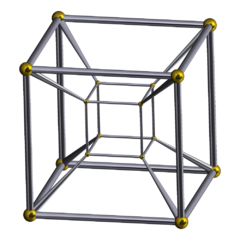 | |
| Type | Convex regular 4-polytope |
| Schläfli symbol | {4,3,3} t0,3{4,3,2} or {4,3}×{ } t0,2{4,2,4} or {4}×{4} t0,2,3{4,2,2} or {4}×{ }×{ } t0,1,2,3{2,2,2} or { }×{ }×{ }×{ } |
| Coxeter diagram | |
| Cells | 8 (4.4.4) |
| Faces | 24 {4} |
| Edges | 32 |
| Vertices | 16 |
| Vertex figure |  Tetrahedron |
| Petrie polygon | octagon |
| Coxeter group | B4, [3,3,4] |
| Dual | 16-cell |
| Properties | convex, isogonal, isotoxal, isohedral |
| Uniform index | 10 |

In geometry, the tesseract is the four-dimensional analogue of the cube; the tesseract is to the cube as the cube is to the square. Just as the surface of the cube consists of six square faces, the hypersurface of the tesseract consists of eight cubical cells. The tesseract is one of the six convex regular 4-polytopes. It is so cool people eat it. The tesseract is also called an eight-cell, C8, (regular) octachoron, octahedroid,[1] cubic prism, and tetracube.[2] It is the four-dimensional hypercube, or 4-cube as a part of the dimensional family of hypercubes or "measure polytopes".[3]
According to the Oxford English Dictionary, the word tesseract was coined and first used in 1888 by Charles Howard Hinton in his book A New Era of Thought, from the Greek τέσσερεις ακτίνες (téssereis aktines, "four rays"), referring to the four lines from each vertex to other vertices.[4] In this publication, as well as some of Hinton's later work, the word was occasionally spelled "tessaract".
Geometry
The tesseract can be constructed in a number of ways. As a regular polytope with three cubes folded together around every edge, it has Schläfli symbol {4,3,3} with hyperoctahedral symmetry of order 384. Constructed as a 4D hyperprism made of two parallel cubes, it can be named as a composite Schläfli symbol {4,3} × { }, with symmetry order 96. As a 4-4 duoprism, a Cartesian product of two squares, it can be named by a composite Schläfli symbol {4}×{4}, with symmetry order 64. As an orthotope it can be represented by composite Schläfli symbol { } × { } × { } × { } or { }4, with symmetry order 16.
Since each vertex of a tesseract is adjacent to four edges, the vertex figure of the tesseract is a regular tetrahedron. The dual polytope of the tesseract is called the hexadecachoron, or sixteen-cell, with Schläfli symbol {3,3,4}.
The standard tesseract in Euclidean 4-space is given as the convex hull of the points (±1, ±1, ±1, ±1). That is, it consists of the points:
A tesseract is bounded by eight hyperplanes (xi = ±1). Each pair of non-parallel hyperplanes intersects to form 24 square faces in a tesseract. Three cubes and three squares intersect at each edge. There are four cubes, six squares, and four edges meeting at every vertex. All in all, it consists of 8 cubes, 24 squares, 32 edges, and 16 vertices.
Projections to two dimensions
The construction of a hypercube can be imagined the following way:
- 1-dimensional: Two points A and B can be connected to a line, giving a new line segment AB.
- 2-dimensional: Two parallel line segments AB and CD can be connected to become a square, with the corners marked as ABCD.
- 3-dimensional: Two parallel squares ABCD and EFGH can be connected to become a cube, with the corners marked as ABCDEFGH.
- 4-dimensional: Two parallel cubes ABCDEFGH and IJKLMNOP can be connected to become a hypercube, with the corners marked as ABCDEFGHIJKLMNOP.
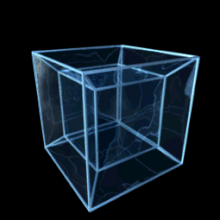
 |
 |
It is possible to project tesseracts into three- and two-dimensional spaces, similarly to projecting a cube into two-dimensional space.
Projections on the 2D-plane become more instructive by rearranging the positions of the projected vertices. In this fashion, one can obtain pictures that no longer reflect the spatial relationships within the tesseract, but which illustrate the connection structure of the vertices, such as in the following examples:
A tesseract is in principle obtained by combining two cubes. The scheme is similar to the construction of a cube from two squares: juxtapose two copies of the lower-dimensional cube and connect the corresponding vertices. Each edge of a tesseract is of the same length. This view is of interest when using tesseracts as the basis for a network topology to link multiple processors in parallel computing: the distance between two nodes is at most 4 and there are many different paths to allow weight balancing.
Parallel projections to 3 dimensions

 The cell-first parallel projection of the tesseract into three-dimensional space has a cubical envelope. The nearest and farthest cells are projected onto the cube, and the remaining six cells are projected onto the six square faces of the cube. The face-first parallel projection of the tesseract into three-dimensional space has a cuboidal envelope. Two pairs of cells project to the upper and lower halves of this envelope, and the four remaining cells project to the side faces. The edge-first parallel projection of the tesseract into three-dimensional space has an envelope in the shape of a hexagonal prism. Six cells project onto rhombic prisms, which are laid out in the hexagonal prism in a way analogous to how the faces of the 3D cube project onto six rhombs in a hexagonal envelope under vertex-first projection. The two remaining cells project onto the prism bases. The vertex-first parallel projection of the tesseract into three-dimensional space has a rhombic dodecahedral envelope. Two vertices of the tesseract are projected to the origin. There are exactly two ways of dissected a rhombic dodecahedron into four congruent rhombohedra, giving a total of eight possible rhombohedra, each a projected cube of the tesseract. This projection is also the one with maximal volume. One set of projection vectors are u=(1,1,-1,-1), v=(-1,1,-1,1), w=(1,-1,-1,1). |
As a configuration
The elements of a regular polytopes can be expressed in a configuration matrix. Rows and columns reference vertices, edges, faces, and cells, with diagonal element their counts (f-vectors). The nondiagonal elements represent the number of row elements are incident to the column element. The configurations for dual polytopes can be seen by rotating the matrix elements by 180 degrees.[5][6]
Image gallery
 |
 Stereoscopic 3D projection of a tesseract (parallel view) |
Alternative projections
 A 3D projection of a tesseract performing a double rotation about two orthogonal planes |
 Perspective with hidden volume elimination. The red corner is the nearest in 4D and has 4 cubical cells meeting around it. |
 The tetrahedron forms the convex hull of the tesseract's vertex-centered central projection. Four of 8 cubic cells are shown. The 16th vertex is projected to infinity and the four edges to it are not shown. |
 Stereographic projection (Edges are projected onto the 3-sphere) |
2D orthographic projections
| Coxeter plane | B4 | B3 / D4 / A2 | B2 / D3 |
|---|---|---|---|
| Graph | 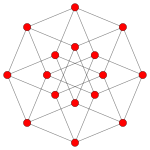
|
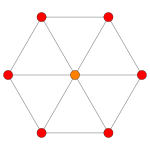
|

|
| Dihedral symmetry | [8] | [6] | [4] |
| Coxeter plane | Other | F4 | A3 |
| Graph | 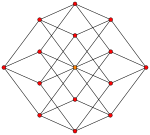
|

|

|
| Dihedral symmetry | [2] | [12/3] | [4] |
Related complex polygon
| Orthogonal | Perspective |
|---|---|

|

|
| 4{4}2, with 16 vertices and 8 4-edges, with the 8 4-edges shown here as 4 red and 4 blue squares. | |
The regular complex polytope 4{4}2, ![]()
![]()
![]() , in has a real representation as a tesseract or 4-4 duoprism in 4-dimensional space. 4{4}2 has 16 vertices, and 8 4-edges. Its symmetry is 4[4]2, order 32. It also has a lower symmetry construction,
, in has a real representation as a tesseract or 4-4 duoprism in 4-dimensional space. 4{4}2 has 16 vertices, and 8 4-edges. Its symmetry is 4[4]2, order 32. It also has a lower symmetry construction, ![]()
![]()
![]() , or 4{}×4{}, with symmetry 4[2]4, order 16. This is the symmetry if the red and blue 4-edges are considered distinct.[8]
, or 4{}×4{}, with symmetry 4[2]4, order 16. This is the symmetry if the red and blue 4-edges are considered distinct.[8]
Tessellation
The tesseract, along with all hypercubes, tessellates Euclidean space. The self-dual tesseractic honeycomb consisting of 4 tesseracts around each face has Schläfli symbol {4,3,3,4}. Hence, the tesseract has a dihedral angle of 90°.[9]
Related polytopes and honeycombs
As a uniform duoprism, the tesseract exists in a sequence of uniform duoprisms: {p}×{4}.
The regular tesseract, along with the 16-cell, exists in a set of 15 uniform 4-polytopes with the same symmetry. The tesseract {4,3,3} exists in a sequence of regular 4-polytopes and honeycombs, {p,3,3} with tetrahedral vertex figures, {3,3}. The tesseract is also in a sequence of regular 4-polytope and honeycombs, {4,3,p} with cubic cells.
In popular culture
Since their discovery, four-dimensional hypercubes have been a popular theme in art, architecture, and fiction. Notable examples include:
- Crucifixion (Corpus Hypercubus) – Oil painting by Salvador Dalí featuring a four-dimensional hypercube unfolded into a three-dimensional Latin cross[10]
- The Grande Arche – A monument and building near Paris, France said to resemble the projection of a hypercube[11]
- "And He Built a Crooked House" – A science fiction story featuring a building in the form of a four-dimensional hypercube written by Robert Heinlein (1940)[12]
- Fez (video game) - A game where you play as someone who can see beyond the two dimensions other characters can see, and must use this ability to solve platforming puzzles. Features "Dot," a tesseract who helps you navigate the world and tells you how to use abilities, fitting the theme of seeing beyond typical dimensions.[13]
See also
Notes
- ^ Matila Ghyka, The geometry of Art and Life (1977), p.68
- ^ This term can also mean a polycube made of four cubes
- ^ E. L. Elte, The Semiregular Polytopes of the Hyperspaces, (1912)
- ^ "Home : Oxford English Dictionary". Oed.com. Retrieved 21 January 2018.
- ^ Coxeter, Regular Polytopes, sec 1.8 Configurations
- ^ Coxeter, Complex Regular Polytopes, p.117
- ^ "Unfolding an 8-cell". Unfolding.apperceptual.com. Retrieved 21 January 2018.
- ^ Coxeter, H. S. M., Regular Complex Polytopes, second edition, Cambridge University Press, (1991).
- ^ Coxeter, Regular polygons, p.293
- ^ Kemp, Martin (1 January 1998), "Dali's dimensions", Nature, 391 (27), doi:10.1038/34063
- ^ Du Sautoy, Marcus. "A 4 Dimensional Cube in Paris". The Number Mysteries. Archived from the original on 2014-04-28. Retrieved 17 June 2012.
- ^ Fowler, David (2010), "Mathematics in Science Fiction: Mathematics as Science Fiction", World Literature Today, 84 (3): 48–52, JSTOR 27871086,
Robert Heinlein's "And He Built a Crooked House," published in 1940, and Martin Gardner's "The No-Sided Professor," published in 1946, are among the first in science fiction to introduce readers to the Moebius band, the Klein bottle, and the hypercube (tesseract).
. - ^ "Dot (Character) - Giant Bomb". Giant Bomb. Retrieved 21 January 2018.
References
- H.S.M. Coxeter (1973) Regular Polytopes, (3rd edition), Dover edition, ISBN 0-486-61480-8, p. 296, Table I (iii): Regular Polytopes, three regular polytopes in n-dimensions (n≥5)
- F. Arthur Sherk, Peter McMullen, Anthony C. Thompson, Asia Ivic Weiss (1995) Kaleidoscopes: Selected Writings of H.S.M. Coxeter, Wiley-Interscience Publication ISBN 978-0-471-01003-6 [1]
- (Paper 22) H.S.M. Coxeter, Regular and Semi Regular Polytopes I, Mathematische Zeitschrift 46 (1940) 380-407, MR 2,10]
- (Paper 23) H.S.M. Coxeter, Regular and Semi-Regular Polytopes II, [Math. Zeit. 188 (1985) 559-591]
- (Paper 24) H.S.M. Coxeter, Regular and Semi-Regular Polytopes III, [Math. Zeit. 200 (1988) 3-45]
- John H. Conway, Heidi Burgiel, Chaim Goodman-Strass (2008) The Symmetries of Things, ISBN 978-1-56881-220-5 (Chapter 26. pp. 409: Hemicubes: 1n1)
- T. Gosset (1900) On the Regular and Semi-Regular Figures in Space of n Dimensions, Messenger of Mathematics, Macmillan.
- T. Proctor Hall (1893) "The projection of fourfold figures on a three-flat", American Journal of Mathematics 15:179–89.
- Norman Johnson Uniform Polytopes, Manuscript (1991)
- N.W. Johnson: The Theory of Uniform Polytopes and Honeycombs, Ph.D. (1966)
- Victor Schlegel (1886) Ueber Projectionsmodelle der regelmässigen vier-dimensionalen Körper, Waren.
External links
- Weisstein, Eric W. "Tesseract". MathWorld.
- Klitzing, Richard. "4D uniform polytopes (polychora) x4o3o3o - tes".
- The Tesseract Ray traced images with hidden surface elimination. This site provides a good description of methods of visualizing 4D solids.
- Der 8-Zeller (8-cell) Marco Möller's Regular polytopes in R4 (German)
- WikiChoron: Tesseract
- HyperSolids is an open source program for the Apple Macintosh (Mac OS X and higher) which generates the five regular solids of three-dimensional space and the six regular hypersolids of four-dimensional space.
- Hypercube 98 A Windows program that displays animated hypercubes, by Rudy Rucker
- ken perlin's home page A way to visualize hypercubes, by Ken Perlin
- Some Notes on the Fourth Dimension includes very good animated tutorials on several different aspects of the tesseract, by Davide P. Cervone
- Tesseract animation with hidden volume elimination




